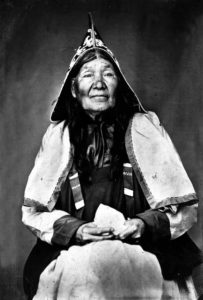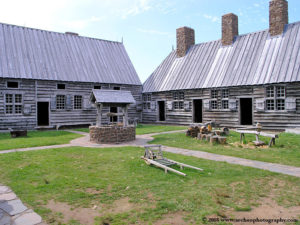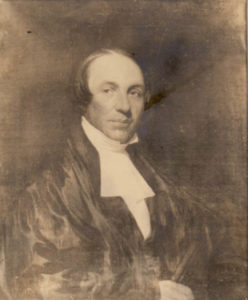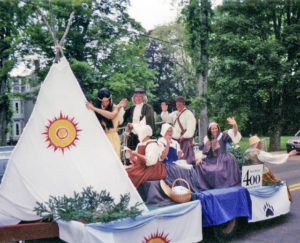History of Annapolis Royal
The Mi’kmaq
Long before the arrival of the Europeans, this geography held special meaning for the Mi’kmaq, the aboriginal people who had occupied most of Canada’s Maritime provinces for thousands of years. To them, the valley was Kespukwik and its primary river was Te’wapskik, meaning “flowing out between high rocks,” perhaps a reference to Digby Gut. As a tribe, the Mi’kmaq acted as middlemen between northern aboriginal hunters and other agriculturists to the south. This age-old role, along with their control of the local fur trade, enabled them to make trading relationships with the French when they arrived.
This moment came in June of 1604 when a French expedition, intent on setting up a fur-trading colony in Acadie, entered the Annapolis Basin. Led by Pierre de Gua, Sieur de Monts, the party included geographer Samuel de Champlain, who named the vast harbour Port Royal. It also included the nobleman Sieur de Poutrincourt, who was so taken with the setting that he was granted the new discovery as a seigneury. Sailing upriver as far as the “narrows,” the French stayed only a short time in the basin before continuing the exploration of La Baie Francaise (the Bay of Fundy).
After a devastating winter spent at Isle-Ste-Croix on the opposite side of the bay, in 1605 the colonists returned to Port Royal, where they erected their “habitation” on the north shore of the basin, opposite Goat Island. Good relations with the local Mi’kmaq, and their chief or sakmow, Membertou, were largely responsible for the survival of the French during their first winters in Acadie. The little settlement achieved some success at agriculture but problems with the monopoly of the fur trade required the absence of de Monts and his successor, Poutrincourt, in order to argue their case in France. The efforts of Poutrincourt and his protégés, Claude La Tour and his son Charles, proved fruitless.
In their absence, the Habitation was burned in 1613 by Samuel Argall, a Virginia privateer. Although short lived, that first attempt at settlement was occasion for other notable “firsts” for Europeans in North America, including the first social club (the Order of Good Cheer), the first performance of a play, and the first grain grown and milled. The establishment of Port Royal in 1605 and the continued settlement of the area made it the first permanent European settlement north of St. Augustine in Florida.
Back and forth
Some of the colonists remained in the area under the leadership of Charles de Biencourt, Poutrincourt’s son, and his friend and heir, Charles La Tour, until the arrival of the Scottish settlers in 1629.
The claims of England and France in the New World overlapped in what are now Canada’s maritime provinces. The same territory that had been granted to de Monts and his associates as Acadie by the French government was in 1621 award by King James I of England to court favourite Sir William Alexander. Interest and financial backing for a proposed colony in Nova Scotia, (Latin for “New Scotland”) were raised when the Order of Knights Baronet of Nova Scotia was created in Britain. It wasn’t until 1629, however, that a group of about seventy Scottish settlers arrived in the Annapolis Basin under Sir William Alexander the Younger. Built farther upriver than the previous French habitation, their fort was named Charles Fort in honour of the Stuart ruler, Charles I. The site they chose is the present-day location of Fort Anne and the town of Annapolis Royal.
Among the new settlers was none other than the senior La Tour, Claude, who, after switching allegiance, became a Knight Baronet of Nova Scotia. The internecine rivalries that would play out later in French Acadie stemmed in part from the claims of the La Tours. Charles La Tour’s entitlement as legitimate heir to Poutrincourt’s seigneury was reinforced by his father’s position with the British. The new settlement did not remain Scottish for long. In 1632, Acadie was returned to the French by the Treaty of Saint-Germain-en-Laye, and the short-lived colony was forced to disband. Its legacy survives in the name, flag and coat-of-arms of the modern province of Nova Scotia.
On their return to Acadie, the French, under Isaac de Razilly, settled initially at La Have on Nova Scotia’s south shore. Following de Razilly’s death, his lieutenant and successor, Charles de Menou d’Aulnay, moved the settlement to Port Royal and the site of Charles Fort. This second attempt at colonization would prove more successful.
The Acadians
D’Aulnay’s initial group of settlers, augmented by colonists from France, grew quickly. Although Port Royal was originally conceived as a fur-trading settlement, the use of the aboiteau system of dyking salt marshes created a distinctive farming culture, one that became characteristic of the Acadian people. D’Aulnay died of exposure in 1650, and the rivalry between d’Aulnay and Charles La Tour (then based on the Saint John River) was resolved with the marriage of La Tour to d’Aulnay’s widow, Jeanne (née Motin). The success of the Acadian settlement was apparent by 1700. From Port Royal, small settlements connected by kinship sprang up around the Bay of Fundy.
Despite the uncertainties of colonial geopolitics, the indifference of various French governments and the near-constant threat of attack by the English, Acadie thrived and a distinct culture was created.
After a century of alternating control, Nova Scotia became British for the last time in 1710 with the capture of Port Royal by a force under Colonel Francis Nicholson, a reality confirmed by the Treaty of Utrecht in 1713. For the next half-century, the town was a British enclave surrounded by a French population. The newly renamed Annapolis Royal remained the capital of the colony until the founding of Halifax in 1749. During this period, the English were represented by the military, the colonial administration, and a few civilians associated with Fort Anne or employed as traders. With France intent on regaining its former possession, the situation for the English was tenuous, and Annapolis Royal endured several sieges before 1745. As the centre of power in Acadie or Nova Scotia for 150 years, the town had been attacked by the English, the French, their proxies in Boston and Quebec, Mi’kmaq, Maliseet, and even privateers! The desire of the generally peaceful Acadians to remain neutral and their unwillingness to sign an unconditional oath of allegiance to the British Crown precipitated their final removal in 1755, just before the outbreak of the Seven Years’ War. Generally regarded as the darkest moment in Nova Scotian history, the expulsion of the Acadians has been romanticized over the intervening centuries, most notably with Longfellow’s poem Evangeline. The event dramatically altered their identity as a people, and scattered them, destitute, among the Thirteen Colonies, Louisiana and France. Of the estimated 10,000 Acadians in 1755, about eight thousand were deported before the proscription against their presence in the colony was lifted in 1764. Acadian property was confiscated and homes, crops and livestock destroyed. The number who returned in later years were relegated to inferior land at the periphery of settlement, their ancestral lands being occupied by English-speaking settlers.
The next wave
For several years after the Explusion, the valley remained virtually empty save for the British enclave at Annapolis Royal. Efforts by the government to recruit settlers in both Old and New England resulted in the arrival of several groups to the area at the conclusion of the Seven Years’ War in 1763. By far the largest body was the New England Planters, third and fourth generation New Englanders who were responding to the offer of land. A number of them had seen firsthand the vacated farms of the Acadians, some as participants in that event, others as militia-men in the subsequent campaigns against the French. Mainly farmers from Massachusetts, they were settled in two new townships created along the shores of the Annapolis River: Granville on the north shore and Annapolis (including Annapolis Royal) on the south shore.
Ulster Scots, remnants of Alexander MacNutt’s ill-fated attempts at colonization, and some of the German families that settled at Lunenburg in 1752 also made their way to the shores of the Annapolis Basin.
In 1774, farmers from Yorkshire, England, responding to a call for settlers, paid their own fare over and, upon arrival, purchased farms in the two townships. They were part of a greater migration of Yorkshiremen who settled in larger numbers in Cumberland County in northern Nova Scotia.
The last large group of immigrants to settle in the area came not by choice, but by necessity. Like the Acadians before them, the Loyalists were unwilling pawns in the geopolitics of the day. Throughout the American War of Independence, a stream of disaffected settlers, many from Massachusetts, the hotbed of republicanism, trickled into the province. At the war’s end, however, large numbers of Loyalists were left behind British lines at New York, the last city held by the English. With the signing of the Treaty of Paris in 1783, some thirty thousand of these refugees, representing all walks of life, were evacuated to Nova Scotia. Their number included a sizeable Black contingent. Some of these people were slaves of Loyalists; many others were escaped slaves from Virginia and South Carolina, guaranteed their freedom by the British and organized into a regiment known as the Black Pioneers. The several thousand Loyalists who arrived in Annapolis Royal in 1783 quickly taxed the meager resources of the town. Many moved on, but substantial numbers of them settled in the established townships or in the newly created townships of Clements and Digby to the west.
Peace and prosperity
The conclusion of the war of 1812 brought to an end the turmoil that had marked most of the previous century. No longer preoccupied with survival, the citizens of Annapolis Royal turned their attention to economic pursuits. In town, the period was marked by the construction of more lavish homes and the growth of a shipping and ship-building industry. Local feeling for the monarchy and Great Britain was strengthened with the accession of Queen Victoria to the throne in 1837 and the creation of an empire. The removal of the garrison from Fort Anne at the outbreak of the Crimean War in 1854 ended the town’s military role. But linked by the sea to that empire’s far-flung points, Annapolis Royal had, by the middle of the century, achieved a level of industry that belied its small size. The growth of agriculture beyond subsistence farming meant that the produce of the Annapolis Valley, in particular apples, required reliable means of transportation. The town’s advantage as a port was enhanced with the completion of the Windsor & Annapolis railway in 1869. That advantage would remain with Annapolis Royal throughout the 1870s and 80s until the completion of the rail line to Digby in 1891. During Nova Scotia’s “Golden Age of Sail,” the town was full of activity. The bustle of the waterfront at a dozen wharves and the several shipyards (not to mention those at Granville Ferry on the other side of the river) was matched by a sharp increase in the construction or moving of buildings. Local industry was remarkably diverse in the last half of the nineteenth and the first years of the twentieth century. The seemingly high rate of business failures did not dampen the enthusiasm for commerce. Enterprising individuals in town wasting no time in bringing in from Boston, New York or London the latest fashions or gadgets (in this age of the patent) and the local paper was full of advertisements for exotic-sounding tonics and elixirs that promised cures for every ailment!
Socially, Annapolis Royal in the late Victorian era contained many elements of a larger and more sophisticated town, with a music hall and a rink, and later a theatre, that provided venues for community entertainment. Besides well-attended church, temperance and fraternal groups, the citizens of town formed social clubs for activities such as tennis, golf, cricket and bridge, as well as drama (the Pickwick Club). In the first decades of the twentieth century, the automobile and the airplane, those pivotal inventions of the time, made their appearance in town. Auto stations and, for a short time, an airport, were visible indicators of Annapolis Royal’s entry into the modern age.
Annapolis Royal today
With a population of fewer than five hundred, Annapolis Royal ranks as the smallest town in Nova Scotia, if not in all of Canada. Its modern economy is based on tourism and its attractions remain the same: the beautiful natural setting that first delighted explorers, and the little town itself, whose story reflects the earliest history of Canada. But Annapolis Royal is no caricature. It is a real town, with vibrant community organizations, a bustling main street, two National Historic Sites, specialty shops and museums, a theatre, a seasonal farmers’ market, a well-developed arts scene and the distinction of being named in 2004 the “Most Liveable Small Town in the World”.












